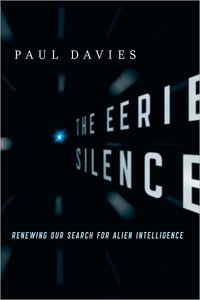Review: The Eerie Silenceby Jeff Foust
|
| “In my opinion,” Davies writes, “the way forward is to stop viewing alien motives and activities through human eyes.” |
Davies, who runs the Beyond Center for Fundamental Concepts in Science at Arizona State University, has been involved in SETI projects “for most of my career”, he writes, but is not interested in providing a hagiographic review of SETI in his book. Instead, he states that he wants to “take a penetrating look at the aims and assumptions of the entire enterprise”, and he does just that in the book, examining why there have been no signals detected—the “eerie silence” from the book’s title—since Frank Drake first trained a radio telescope on the nearby stars Tau Ceti and Epsilon Eridani in 1960. The radiotelescope searches that have dominated “traditional” SETI since its inception, he argues, is unlikely to succeed, thanks to an “inbuilt bias towards anthropocentrism”; that is, a belief among researchers that alien civilizations, if they exist, would be like us, at least to the extent of transmitting at radio frequencies.
“In my opinion,” Davies writes, “the way forward is to stop viewing alien motives and activities through human eyes.” That means less of an emphasis on traditional SETI in favor of alternative means of detecting evidence of intelligent life, if not a message from them. Davies suggests searching for evidence a wide range of markers that an extraterrestrial civilization, particularly one far more advanced from the Earth, would leave behind, such as Dyson spheres. However, that assumes that intelligence life does exist beyond Earth, something Davies examines, as well as whether they would be interested in communicating with anyone. He argues that biological intelligence is a “transitory” phenomenon that would inevitably give way to machine intelligence that may choose to simply retreat into its own cyberspace, uninterested in the physical universe at all, let alone communicating with any other intelligence out there.
At the end of this slender, eminently readable volume, Davies tackles the question at the root of SETI: are we alone? As a scientist, he concludes that we are probably the only intelligent life in the observable universe, given all the challenges (discussed in the book) for the evolution of such life. As a philosopher, that conclusion makes him uneasy: “I wonder what all that stuff out there is for,” he writes. But as a human being, he says he still has a “wide-eyed schoolboy fascination” about alien life and intelligence that has survived scientific skepticism. “I can think of no more thrilling a discovery than coming across clear evidence for extraterrestrial intelligence,” he concludes. That discovery has yet to come, and as The Eerie Silence notes may never come, particularly using traditional search techniques, but that doesn’t mean it’s not worth some degree of effort to try and answer one of the most fundamental questions of our existence.
